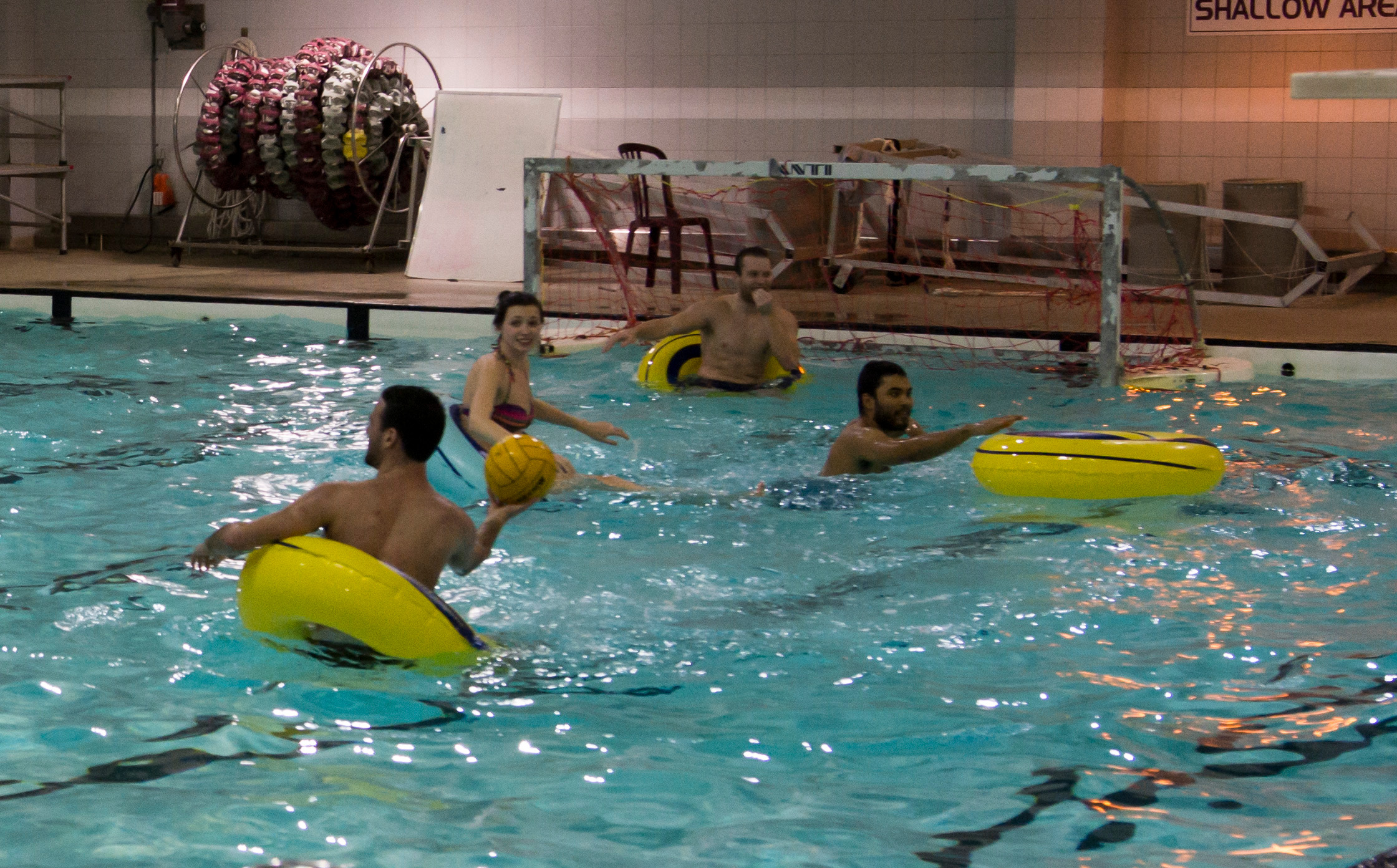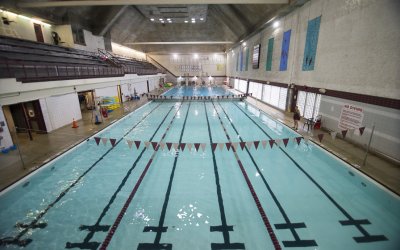Programs & Services: Intramural Sports
Intramural Innertube Water Polo
Sport leagues and tournaments for the entire McMaster community, beginner to advanced, individual or team: We want to play with you! Offered fall/winter only.
 Need an accommodation? Submit Accommodation Request
Need an accommodation? Submit Accommodation Request
For more information: intramurals@mcmaster.ca

Activities include: Innertube Water Polo, Water Polo, Aquatics
Fall & Winter Leagues
- When are leagues and tournaments in this sport offered? What PlayStyles are available?
Check the Sport Calendar on the 'SPORTS' tab of our Intramural Sports page.
- Who can play Intramural Sports at McMaster? How do I register?
Check the 'REGISTER' tab of our Intramural Sports page.
- Accessible
- Registration Required
Facilities
Innertube Water Polo Rules
A) PLAYERS
1. OPEN - No gender ratio requirements for the amount of players in pool during gameplay. Maximum 6 players; Minimum 4 players.
2. COREC - Maximum: 6 players - 3 men and 3 women; Minimum: 2 men, 2 women.
a) Teams short women must play with one less male for every missing female (i.e., if you have only 2 females then only 2 males are allowed).
b) Women may substitute for men in the lineup without penalty.
c) Your opposition may allow you to play with more males - this must be agreed upon prior to the start of the game.
3. WOMEN'S - Womens league, Maximum 6 players; Minimum 4 players.
B) GAME SETUP:
1. Playing Area: 25 meter pool with official water polo nets at each side.
2. Game Length: Two 18 minute halves will be played with a 4 minute half-time in between. (Game staff may shorten games to accommodate pool scheduline.)
C) GAME PLAY:
1. To begin play, the teams line up, with all players touching their 'end-wall' (at the opposite ends of the pool). The referee will blow their whistle signaling players to swim toward the centre of the pool, where they will have thrown the ball for a swimming face-off.
2. Out of Bounds: If the ball goes out of bounds onto the pool deck (behind the goal, or along the sides), the team to last touch the ball will be penalized by awarding possession to the opposing team.
a) Shots on net deflected behind the goal and out of bounds by the goalie will be deemed goalie's ball.
b) If a defensive player other than the goalie tips the ball out of bounds behind the goal, the opposition will be awarded possession at the side of the pool in line with the 2-meter line.
2. Substitutions: Substitutions are allowed on the fly or after a whistle. If changing players on the fly, the new player must wait on the pool deck until their sub is completely out of the water; failure to comply will result in possession being awarded to the other team. Subs not in play must be out of the pool on the pool deck.
2. No player may hold onto the side of the pool or goal/net when catching, receiving or passing the ball. A penalty may be assessed resulting in a free-throw for the opposing team.
3. The goalkeeper's area is denoted by the 2-metre line, and is highlighted by markers on the pool deck. No other player - offensive or defensive - is allowed in this area.
a) Offensive violation: Possesion awarded to the goalie - 'goalies ball'.
b) Defensive violation: Free-throw from the closest side of the pool for the offensive team.
4. The goalkeeper may not throw the ball past half while in the goal area (within the 2 meter line). Outside the goal area, he/she must conduct him/herself as any other player. Violation will result in possession being given to the opposition.
5. No player may touch the ball while not sitting in their innertube - subject to referee's discretion (i.e., if a player is falling out of the tube and making a pass play may be allowed to continue). If a goalkeeper leaves or falls out of his/her innertube while attempting to stop a shot which (in the referee's judgment) was on target to enter the net, a goal is awarded.
9. A goal is scored only after the whole ball crosses the goal line.
10. Blind Throws: Throws made while a player cannot see their target (e.g., backhanded or over their head while their back is to their target) are penalties and will be assessed as a Major Foul (see below).
11. Jump Balls: When players of opposite teams maintain contact with the ball, but with neither player attaining clear possession after 5 seconds, a jump ball will be awarded. Possession will be awarded based on a 'possession arrow' similar to that in basketball (whoever lost the face-off at the start of that half will be awarded possession following the first jump ball; possession switches with each subsequent jump ball).
12. Playoff Ties: In playoff games only, ties will be decided by one five-minute, sudden-death overtime. If still tied, a sudden-death shootout will be taken from the penalty spot, located where the midline of the pool intersects the 4 meter line).
D) SUMMARY OF FOULS
1. Minor Fouls: Free throw is awarded to the nearest opponent. A minor foul occurs when:
a) A player makes contact with another player's tube using their hands/arms or legs/feet - tube on tube contact only!
b) A player deliberately touches the pool wall while in possession of the ball.
c) The goaltender throws the ball more than half the length of the pool from within the 2-metre line. (Free throw to be taken at half.)
d) A player plays inside the 2-metre line who is not the designated goalkeeper.
e) Holding the ball underwater.
f) Cradling the ball in the lap. The ball must be kept up, with arms extended to a height above the head.
2. Major Foul: Offending player is out of the pool and in the penalty area for 2 minutes. A major foul occurs when:
a) A player dunks or dumps another player.
b) A player persistently repeats a minor foul even after an official warning.
c) A player interferes with a free throw.
3. Personal Disobedience: Offending player shall be removed from play for the remainder of the game. Personal disobedience without replacement occurs when:
a) A player attacks, strikes, or kicks an opponent in such a manner as, in the opinion of the referee, to endanger the person in anyway.
b) A player deliberately throws the ball at an opponent with the intent to injure.
c) A player blatantly refuses to obey the officials' requests.
d) A player exhibits unsporting behaviour.
